|
|
 |
|
Calanoida ( Order ) |
|
|
|
Arietelloidea ( Superfamily ) |
|
|
|
Augaptilidae ( Family ) |
|
|
|
Euaugaptilus ( Genus ) |
|
|
| |
Euaugaptilus longimanus (Sars, 1905) (F,M) | |
| | | | | | | Syn.: | Augaptilus longimanus Sars, 1905 c (p.17, Descr.F); Wolfenden, 1911 (p.340, figs.F) | | | | Ref.: | | | Sars, 1925 (p.282, figs.F,M); Rose, 1929 (p.35); Lyshom & al., 1945 (p.38); Sewell, 1947 (p.198, 199, 201, 223, figs.F, juv.F,M); Tanaka, 1964 b (p.69, figs.F); Vervoort, 1965 (p.143, Rem.); Tanaka & Omori, 1967 (p.253, figs.F, Rem.); Owre & Foyo, 1967 (p.86, figs.F,M); Matthews, 1972 (p.35); Tanaka & Omori, 1974 (p.230, figs.F,M); Chihara & Murano, 1997 (p.728, Pl.57: F,M ); Bradford-Grieve & al., 1999 (p.882, 939, figs.F,M); Bradford-Grieve,1999 b (p.55, figs.F,M, figs.171, 190); Matsuura & Nishida, 2000 (p.339, figs., Rem.); Vives & Shmeleva, 2007 (p.225, figs.F,M, Rem.) | 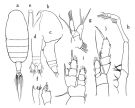 issued from : O. Tanaka in Publs Seto Mar. Biol. Lab., 1964, XII (1). [p.70, Fig.208]. Female: a, habitus (dorsal); b, forehead (left lateral side); c, last thoracic segment and urosome (left lateral side); d, urosome (dorsal); e, rostrum (frontal view); f, Md (mandibular palp and masticatory edge, separately); g, Mx1; h, Mxp; i, P1; j, P5. Nota: The urosome segments and furca are in the proportional lengths as 60:12:7:21 = 100. A1 exceeds the end of the furca by terminal 3 segments. The specimen differs in the structure of the Md from that described and figured by Sars.
|
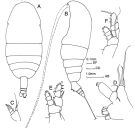 issued from : J.M. Bradford-Grieve in The Marine Fauna of New Zealand: Pelagic Calanoid Copepoda. National Institute of Water and Atmospheric Research (NIWA). NIWA Biodiversity Memoir, 111, 1999. [p.55, Fig.27]. Female: A, habitus (dorsal); B, idem (left lateral side); C, Md (mandibular palp); D, Mx1; E, P1; F, P5.
|
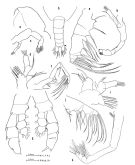 issued from : O. Tanaka & M. Omori in Publs Seto Mar. Biol. Lab., 1974, XXI (3/4). [p.231, Fig.17]. Male: a, forehead (lateral); b, last thoracic segment and urosome (dorsal); c, A2; d, Mx1; e, Mx2; f, Mxp; g, P5. Nota: The urosome segments and furca are in the proportional lengths as 25:19:19:12:7:18 = 100. Prosome and urosome are in the proportional lengths as 77:23. The right A1 extends beyond the tip of the furca by 6 segments; Left A1 is geniculated. Female: h, A2; i, Mx1; j, Mx2; k, Mxp (without 1st basal segment).;
|
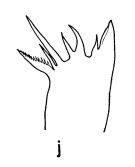 issued from : O. Tanaka & M. Omori in Publs Seto Mar. Biol. Lab., 1974, XXI (3/4). [p.200, Fig.3,j]. Female: j, mandibular teeth.
|
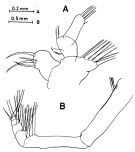 issued from : O. Tanaka & M. Omori in Information Bull on Planktology in Japan. Commemoration Number of Dr. Y. Matsue's Sixtieth Birthday, December 1967. [p.253, Fig.5]. Female: A, Mx1; B, Mxp (without the 1st basal segment). Nota: The species has a very characteristic features in the Mxp: 1st segment of endopod is very long. There are some variations in its structure. According to Sars (1925) the 2nd basal segment of the female has 2 setae on its inner distal margin. The specimens from the Arabian Sea have the same structure in female, but the setae are absent in male (Sewell, 1947). Wolfenden's (1911) specimen has a single seta, whereas in Japanese ones, those setae are absent both in female and male.
|
 issued from : R.B.S. Sewell in The John Murray Expedition, 1933-34, Scientific Reports, VIII (1), 1947. [p.224, Fig.60, A-D]. Female (from N Arabian Sea): A, A2; B, Mx1; C, exopod of P3; D, P5. Nota: proportional lengths of the various segments of the body (cephalon to caudal rami) as 371:145:73:76:94:121:34:40:46 = 1000. A1 25-segmented, overreaches the tip of the caudal rami by about the last 5 or 6 segments. The ebdopod of the palp of palp of Md is very short (1 long segment and a very short apical portion, that is partially separated and bears 2 setae (differs from Sars's specimen, in which there was only a single apical seta); exopod 5-segmented, of which the five each bears a single seta. In Mx1 the basal segment 2 bears 1 seta; the exopod bears 3 setae. The external lobe differs on the two side: on the right side it bears 5 large and 1 very small seta, on the left side the 6th seta is absent. Wolfenden states that there are 3 setae on the outer lobe. In Mx2 the number of setae of the various lobes: lobe 1 (1 large and 1 very small and rudimentary, lobe 2 (1 seta), lobe 3 (1 seta), lobe 4 (3 setae), lobe 5 (2 setae), lobe 6 (2 setae); endopod (7 setae); All the setae from lobes 5 and 6 and from endopod are provided with \"buttons\". A large gland, extending the whole length of the segment, is situated in exopod 3 of The P3, it opens to the exterior by a large pore just below the terminal spine.
|
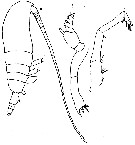 issued from : R.N. Wolfenden in Die Marinen Copepoden der Deutschen Südpolar-Expedition 1901-1903, 1911. [p.340, Fig.73]. As Aupagtilus longimanus. Female (from SW Ascension Island): a, habitus (lateral); b, Md; c, Mxp.
|
 issued from : H. Matsuura & S. Nishida in Mar. Biol., 2000, 137. [p.340, Fig.1]. Female (eastern Indian and NW Pacific): A, Mx2; B, Mxp Nota: Arrangement of button setae (arrowheads) and transitional part (tp) are indicated. Number of button setae on Mx2: 1 on basis, 8 on endopod; on Mxp: 8 on endopod.
|
 issued from : H. Matsuura & S. Nishida in Mar. Biol., 2000, 137. [p.341, Fig.2, E-F]. Female (SEM micrographs of button setae on Mx2 and Mxp): A, subterminal part of a seta; B, transitional part of a seta. Nota: The discs are circular, and sucker-like. In the button setae the basal-most setules are replaced distally by small buttons which form two rows on the middle part and gradually increase to alternately arranged discs, ca. 0.014 mm in diameter, more distally. The diameter of the discs gradually decreases distally to ca. 0.009 mm at the tip of the seta.
|
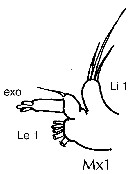 issued from : J.M. Bradford-Grieve, E.L. Markhaseva & C.E.F. Rocha & B. Abiahy in South Atlantic Zooplankton, Edit. D. Boltovskoy. 1999. Vol.2. Copepoda. [p.1038, Fig. 7.254]. Female: Mx1. Nota: Exopod of Mx1 with 3 setae; outer lobe 1 with 5 setae
|
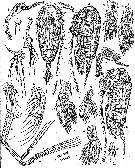 Issued from : G.O. Sars in Résult. Camp. Scient. Prince Albert I, 69, pls.1-127 (1924). [Pl.XCII, figs.1-17]. Female: 1, habitus (dorsal); 2, idem (lateral left side); 3, rostrum; 4, A2; 5, Md; 6, Mx1; 7, Mx2; 8, Mxp; 9, portion of distal seta of Mxp (enlarged); 10, P1; 11, P2; 12, P3; 13, P5. Male: 14, habitus (lateral left side); 15, A2; 16, right P5; 17, exopodal segments of left P5.
|
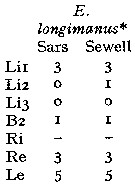 issued from : J.B.L. Matthews in Bull. Br. Mus. (Nat. Hist.) Zool., 1972, 24 (1). [p.25, Table 2]. Differences in setation of Mx1, according to previous descriptions. Nota: * Sewell's specimen was very much larger (9.50 mm) than is usual for this species (c.a 4.5-6.0 mm).
| | | | | Compl. Ref.: | | | Sewell, 1948 (p.330, 504, 522, 528, 530, 533); C.B. Wilson, 1950 (p.205); Grice, 1963 a (p.496); Grice & Hulsemann, 1965 (p.224); 1967 (p.18); Furuhashi, 1966 a (p.295, vertical distribution in Oyashio/Kuroshio transitional area, Table 8); Morris, 1970 (p.2301); Itoh, 1970 (tab.1); Roe, 1972 (p.277, tabl.1, tabl.2); Björnberg, 1973 (p.348, 386); Deevey & Brooks, 1977 (p.156, tab.2, Station "S"); Vives, 1982 (p.294); Guangshan & Honglin, 1984 (p.118, tab.); Lozano Soldevilla & al., 1988 (p.60); Heinrich, 1990 (p.18); Matsuura & al., 2010 (p.2098, Table 2, 3, fig.8) | | | | NZ: | 12 | | |
|
Distribution map of Euaugaptilus longimanus by geographical zones
|
| | | | | | | | | | Loc: | | | off S Ascension Is., G. of Guinea, Canary Is., off Morocco-Mauritania, Azores, Caribbean, Florida, off Bermuda (Station "S"), Sargasso Sea, Arabian Sea, G. of Oman, Indian, Celebes and Sulu Seas, Japan (Izu region), Sea of Philippines, China Seas (East China Sea), Pacif. (tropical), off N Hawaii, E Tuamotu Is., off Peru, Pacif. (SE tropical), N Chile, Pacif. (W equatorial), New Zealand N (North Island) | | | | N: | 29 | | | | Lg.: | | | (1) F: 5,8; (10) F: 5,3; (11) F: 9,5; (16) F: 5,21-4,3; (68) F: 5,81-5,3; M: 5,72 (ou 5,62 !?); (69) F: 4,93; (70) F: 9,5; (199) F: 5,92-5,12; (866) M: 5,72-6,3; (909) F: 5,7; (1066) F: 4,5-4,6; {F: 4,30-9,50; M: 5,72-6,30} | | | | Rem.: | Bathypelagic. Known to occur at depths from below 1000 m to less than 600 m, occasionally near the surface (Matthews, 1972). Sargasso Sea: 1000-1500 m (Deevey & Brooks, 1977, Station "S"). 660-900 m at Station S 2 in S Bösö (E middle Japan).
According to Tanaka & Omori (1967, p.253) this species would present populations comprising two very different size groups in the same geographic area (cf for example in Pessotti & al., 1986, p.409, concerning Temora longicornis). A slight structural differences are observed between the large and ordinary forms. In the former one, Mx1 has the following spinulation on various lobes: 6 setae on the outer lobe, 4 on the 1st inner lobe, 0 on the 2nd inner lobe, rudimentary 1 on the 3rd inner lobe. Sewell's (1947) specimen has a single seta on the 3rd inner lobe. In the specimen from Sagami Bay measuring 4.93 mm has no setae on the 3rd inner lobe.
For Itoh (1970 a, fig.2, from co-ordonates) the Itoh's index value from mandibular gnathobase = 1665.
In ''affinis"" Group after Matthews (1972, p.64) {See remarks in Euaugaptilus genus} | | | Last update : 18/08/2018 | |
|
|
 Any use of this site for a publication will be mentioned with the following reference : Any use of this site for a publication will be mentioned with the following reference :
Razouls C., Desreumaux N., Kouwenberg J. and de Bovée F., 2005-2025. - Biodiversity of Marine Planktonic Copepods (morphology, geographical distribution and biological data). Sorbonne University, CNRS. Available at http://copepodes.obs-banyuls.fr/en [Accessed January 01, 2026] © copyright 2005-2025 Sorbonne University, CNRS
|
|
 |
 |














